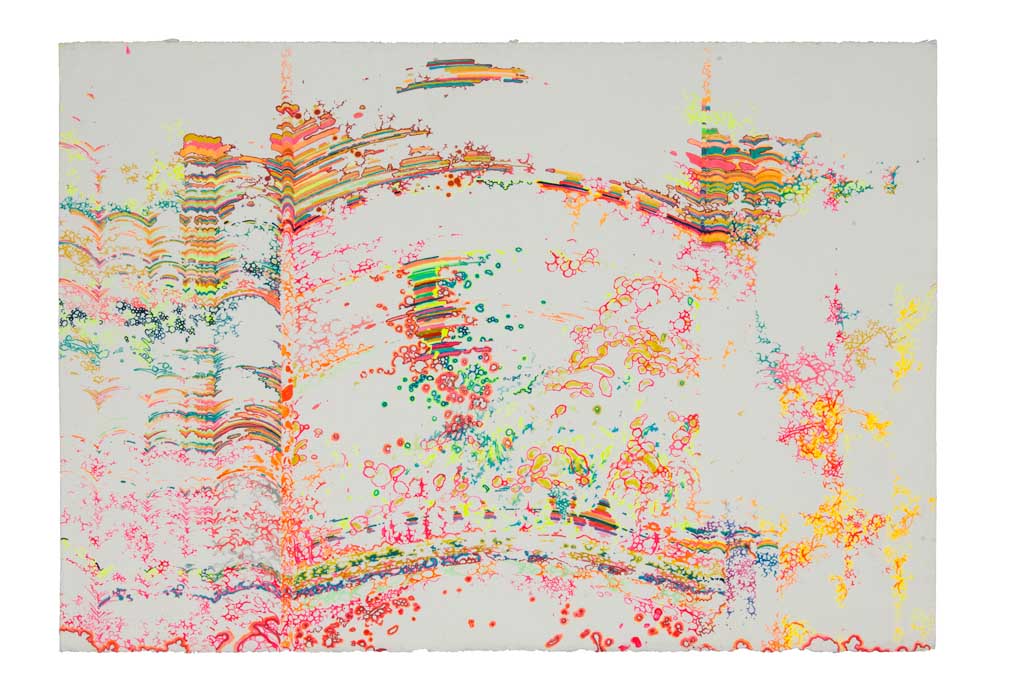Zhou Fan 周范 has come a long way since his breakthrough series of artworks. These were inspired by a dream he had that involved jellyfish floating in the sky, and falling to the ground before becoming mushrooms. Those old, albeit memorable, psychedelic, trippy paintings seem far removed from Zhou Fan’s work today.
Born in 1983 in Shanxi Province in northern China, Zhou graduated from the art department of Shanxi University in 2006. In 2007 he was selected as one of the top 25 emerging Chinese artists (out of over 1300 applicants) at the Chinese Art Prize (CAP). He has become known for his astonishingly detailed drawings and paintings that depict fantastical nature scenes. Often working without drafts, plans or pre-set ideas, Zhou’s large works take from eight months to three years to finish.
So how did Zhou Fan’s work develop from cartoon-like trippy dreams to the Landscape and Rainbow Highway series of works exhibited at Art Labor in 2015? “I decided my new work directions in the Landscape series. I wanted to give up all the emotional elements and perceptual factors. Visually they should appear calm and solid. The Landscape series includes several pictures of natural landscapes mixed with artificial landscapes. In each of the pictures, the horizon has an obvious leading role and splits the picture into two. A larger proposition of ‘nothingness’ lies behind these pictures”.
Zhou Fan’s works of landscapes started in 2013, a conscious move away from his earlier cartoon style, the artist wanting to achieve a higher visual standard and to meet his own demand for two-dimensional art that matched the themes of his work. He elaborates: “My works of landscapes started from 2013 fundamentally meet the two requirements above. I completed a transformation by choosing the pure natural scenes and cutting off the main character who has a strong narrative feature.”
This transformation is important because it made it possible for Zhou Fan to work in more directions, allowing him to continuously evolve and not be typecast as a cartoonist, or other such type labels. “When I first started making art I found the visual style of cartoon easier to accord with my personal interests and to match with the content of my paintings. The cartoon style meets the requirements and has the elements of what I wanted to represent in my works: the widespread use of colour, the pileup of figural images, and the visual processing skill of complexity.”
Following his solo exhibition, Mute, at Art Labor Gallery in 2015, Zhou Fan’s evolution continued with a reduction of the emotional factors and narrative themes of his previous works. He reached a new layer of perception – between nature and man – and entered into an area of psychology with his Phobia series. “As I said, huge transitions like this all come from self-judgments,” he suggests, an artist content that he has been able to, and indeed has succeeded, in developing while remaining relevant and interesting.
Phobia is a new series Zhou Fan has been working on since the end of 2015. He explains: “The title itself indicates the subject of the works; the most acute and sensitive part between self-perception and reality. Phobia is close to the critical point between self-experience and reality. Visually, it appears enlarged or compressed, which is exactly what I needed for my work.”
It seems that Zhou Fan is now more interested in the rational part of the job of being an artist, painting a means to accomplish this rationality. His work is direct, independent and stable, and this is surely why Apple commissioned him to be part of their 2017 Chinese New Year advertising campaign for the Mac Book Pro, a wonderful achievement for a contemporary artist true to his core artistic values.






















